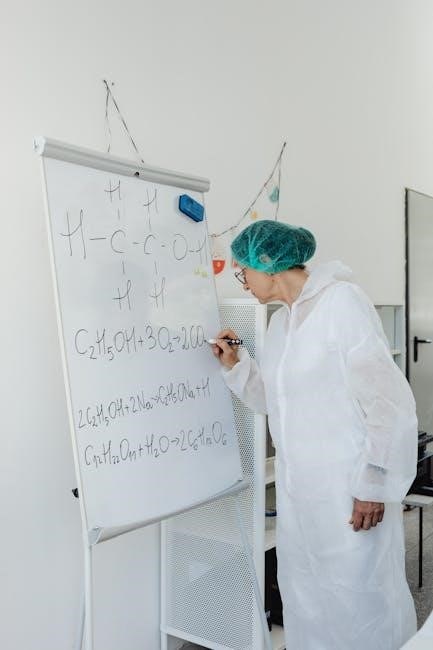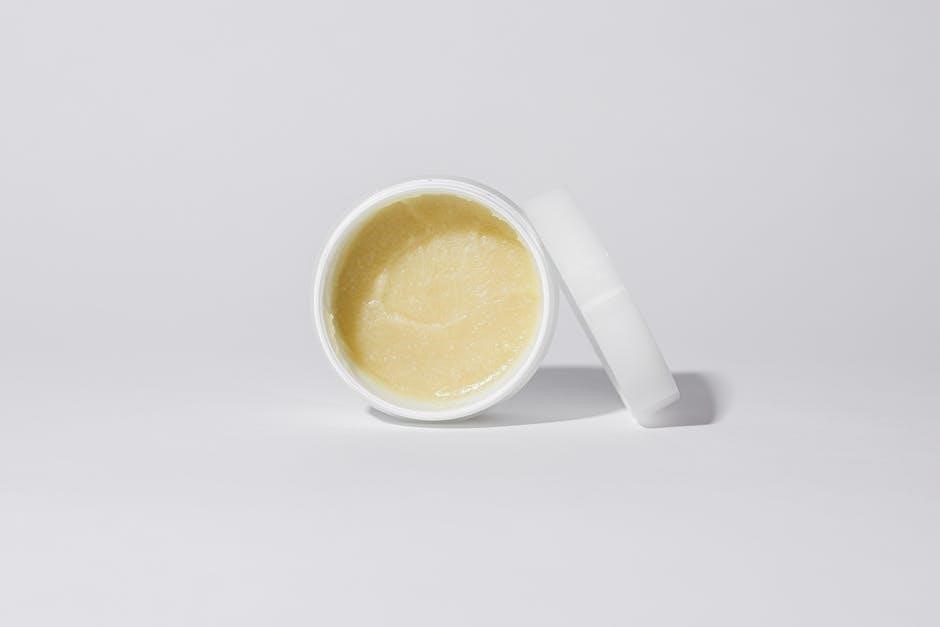Molecular and empirical formulas are fundamental in chemistry, representing the composition of compounds. The empirical formula shows the simplest whole number ratio of atoms, while the molecular formula reveals the actual number of atoms in a molecule. Understanding both is crucial for chemical analysis and compound identification.
Understanding the Basics of Chemical Formulas
Chemical formulas are symbolic representations of the composition of chemical compounds. They convey essential information about the types and proportions of atoms within a molecule. Empirical formulas represent the simplest whole number ratio of atoms in a compound, while molecular formulas indicate the actual number of atoms present. For example, the empirical formula for glucose is CH₂O, while its molecular formula is C₆H₁₂O₆. Understanding these concepts is foundational for solving problems involving chemical composition and structure. These formulas are derived from experimental data, such as mass percentages of elements or molecular weight measurements. Mastery of this topic is critical for success in chemistry, particularly when working with compounds in various fields like biology, engineering, and materials science.

Determining Empirical Formulas
Determining empirical formulas involves converting mass percentages to moles, finding the simplest whole number ratio, and ensuring the ratio is in the smallest possible integers. This process reveals the compound’s simplest atomic composition, essential for further chemical analysis and calculations.
Step-by-Step Process to Find the Simplest Whole Number Ratio
To determine the simplest whole number ratio for an empirical formula, start by converting the given mass percentages or grams of each element into moles using their molar masses. Next, divide each mole value by the smallest number of moles to find the simplest ratio. If the ratio isn’t whole numbers, multiply through by a common factor until whole numbers are achieved. For example, if the moles of elements A, B, and C are 2, 1, and 3 respectively, dividing by 1 gives the ratio 2:1:3. This process ensures the empirical formula reflects the simplest atomic composition of the compound.
Converting Mass Percentages to Moles
To convert mass percentages to moles, start by converting the percentages to grams, assuming a 100g sample for simplicity. Then, divide each element’s mass by its molar mass to find the number of moles. For example, if a compound contains 60% carbon (C) and 40% oxygen (O), assume 60g of C and 40g of O. Using their molar masses (12.01 g/mol for C and 16.00 g/mol for O), calculate moles: 60g / 12.01 g/mol = 5 mol C and 40g / 16.00 g/mol = 2.5 mol O. These mole values are then used to determine the simplest whole number ratio for the empirical formula.
Calculating Molecular Formulas
Molecular formulas are determined by multiplying the empirical formula by a factor ‘n’ derived from the molar mass. This step scales the simplest ratio to the actual molecule composition.
Using Molar Mass to Determine the Multiplier (n Factor)
To find the molecular formula, first, calculate the empirical formula’s molar mass. Divide the compound’s molar mass by the empirical mass to find the multiplier ‘n’. This factor scales the empirical formula to the molecular level by multiplying each subscript by ‘n’. For example, if the empirical formula’s molar mass is 50 g/mol and the molecular molar mass is 150 g/mol, the multiplier is 3. This process ensures the molecular formula accurately represents the compound’s structure. Accurate calculation of ‘n’ is crucial for determining the correct molecular formula, as errors here lead to incorrect representations of the compound’s composition.
Scaling Up the Empirical Formula
Once the empirical formula is determined, scaling it up involves multiplying each subscript by a factor ‘n’ to obtain the molecular formula. This factor is calculated by dividing the compound’s molar mass by the molar mass of the empirical formula. For example, if the empirical formula is CH₂O and the molar mass is 60 g/mol, and the empirical mass is 30 g/mol, the multiplier ‘n’ is 2. Multiplying each subscript by 2 gives the molecular formula C₂H₄O₂. This step ensures the molecular formula represents the actual number of atoms in a molecule, providing a complete picture of the compound’s structure. Accurate scaling is essential for identifying the correct molecular formula.

Sample Problems and Solutions
Sample problems provide practical examples for determining empirical and molecular formulas. Solutions guide students through calculations, such as converting mass percentages to moles and finding ratios. Key steps include identifying the simplest whole number ratio for empirical formulas and scaling up to molecular formulas using molar mass. These examples help reinforce understanding and application of formula determination methods. Real-world compounds are often used to illustrate common scenarios, ensuring students can apply their knowledge to various chemical problems.
Example 1: Determining the Empirical Formula of a Compound
Let’s determine the empirical formula of a compound composed of 68.4% chromium (Cr) and 31;6% oxygen (O). First, assume a 100g sample to simplify calculations. Convert the masses to moles:
moles of Cr = 68.4g / 52.00g/mol = 1.315
moles of O = 31.6g / 16.00g/mol = 1;975
Next, divide each mole value by the smallest number of moles to find the simplest whole number ratio:
Cr: 1.315 / 1.315 = 1
O: 1.975 / 1.315 ≈ 1.5
To eliminate the decimal, multiply both values by 2, resulting in a ratio of 2:3. Therefore, the empirical formula is Cr₂O₃.
Example 2: Finding the Molecular Formula Given the Molar Mass
Given a compound with an empirical formula of CH₂O and a molar mass of 180 g/mol, we calculate the molecular formula. First, determine the empirical formula mass:
12.01 (C) + 2.016 (H₂) + 16.00 (O) = 30.026 g/mol.
Next, divide the molar mass by the empirical formula mass:
180 / 30;026 ≈ 6.
Multiply the empirical formula subscripts by this factor:
(CH₂O)₆ = C₆H₁₂O₆. Thus, the molecular formula is C₆H₁₂O₆, commonly known as glucose.

Common Mistakes and Tips
Common mistakes include incorrect mole conversions and ratio simplification. Always double-check calculations and ensure formulas are in simplest whole numbers. Practice regularly to avoid errors.
Avoiding Errors in Calculations and Interpretations
Avoiding errors in calculations and interpretations is crucial when determining molecular and empirical formulas. One common mistake is incorrect conversion of mass percentages to moles. Always ensure precise calculations by dividing each element’s mass by its molar mass. Another error is failing to simplify the ratio correctly; small discrepancies can lead to wrong formulas. Additionally, when scaling up from empirical to molecular formulas, ensure the multiplier is accurately determined by dividing the molecular weight by the empirical formula weight. Double-checking each step can help prevent these errors and ensure accurate results.
Best Practices for Solving Formula Problems
Best practices for solving molecular and empirical formula problems involve systematic approaches. Start by converting given percentages or masses to moles. Always ensure accurate molar mass calculations. When simplifying ratios, divide each element’s mole value by the smallest to find the simplest whole number ratio. For molecular formulas, calculate the molecular weight and determine the multiplier by dividing it by the empirical formula weight. Verify all steps to avoid errors. Using worksheets or online tools can help organize data and reduce mistakes. Regular practice enhances problem-solving skills and understanding of chemical composition. Consistent attention to detail ensures correct and reliable results in determining both empirical and molecular formulas.

The Importance of Molecular and Empirical Formulas
Molecular and empirical formulas are crucial in chemistry for identifying compounds and understanding their structures. They aid in chemical synthesis, analysis, and communication among scientists, ensuring clarity and precision in compound representation and research applications.
Applications in Chemistry and Real-World Scenarios
Molecular and empirical formulas are essential in chemistry for identifying compounds and their structures. They are used in chemical synthesis to ensure correct stoichiometric ratios, aiding in the production of drugs, materials, and fuels. In pharmaceuticals, molecular formulas help develop medications by understanding their composition. In environmental science, these formulas are used to analyze pollutants and their effects. They also play a role in food chemistry, ensuring safety and quality by identifying ingredients. Additionally, molecular and empirical formulas are critical in materials science for designing new substances with specific properties. These applications highlight their importance in advancing scientific research and solving real-world problems, making them indispensable tools in chemistry and related fields.
Answer Key and Worksheet
The answer key and worksheet provide solutions and practice problems for determining empirical and molecular formulas, helping students master chemical composition calculations effectively.
Empirical and Molecular Formula Worksheet with Solutions
This worksheet offers a comprehensive set of problems and solutions to help students practice determining empirical and molecular formulas. Each problem provides the necessary data, such as mass percentages or molar masses, guiding students through the steps to find the correct formulas. The solutions are detailed, showing the conversion of masses to moles, simplifying ratios, and scaling up to molecular formulas when required. Topics include compounds with varying elemental compositions, ensuring a diverse range of practice. By working through these exercises, students can refine their understanding and improve their problem-solving skills in chemical formula determination.
Summarizing Key Concepts and Takeaways
Understanding molecular and empirical formulas is crucial in chemistry for analyzing compounds. The empirical formula represents the simplest whole number ratio of atoms, while the molecular formula shows the actual number of atoms. To determine these, convert mass percentages or grams of elements to moles, then find the simplest ratio for the empirical formula. The molecular formula is derived by scaling the empirical formula using the molar mass. Practice problems and worksheets help master these concepts, emphasizing accuracy in calculations and avoiding common errors. These skills are essential for identifying compounds and understanding their properties, with applications in fields like biochemistry, materials science, and pharmaceuticals.